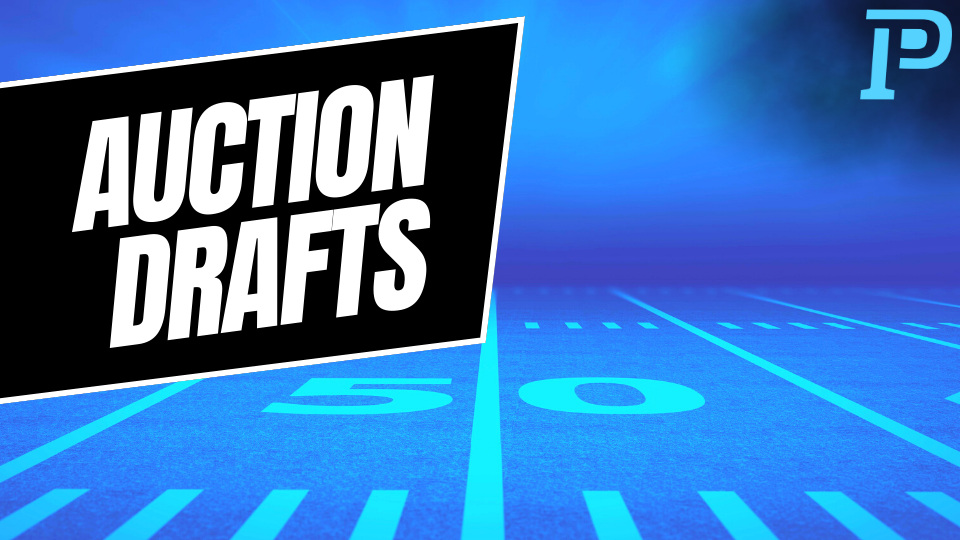This is the ultimate auction strategy guide for fantasy football leagues in 2023.
Acing the Auction: A Guide to Fantasy Auction Dominance
by Dan Williamson
So your league is doing an auction this year. Whether you’ve never participated in an auction draft before or you’ve got a decent amount of experience at them, I’m here to help you sharpen your game. I’ve won multiple high-stakes auctions drafted both online and in person. First, we’re going to explore a fundamental concept of auction pricing, the Value Curve. Then, in Part II, I’m going to show you how you can set yourself up for maximum success in any auction by helping you prep for your auction. This preparation will make it so you’ll never feel caught off guard no matter what happens as the auction action unfolds.
Then in Part III, we’ll cover the four main sections of every auction (Pre-Game, Early Action, Midgame Strategy, and the Endgame). I’ll show you how to handle each of these aspects along with some general tips to use throughout the auction. In Part IV, we get to the REALLY fun part. This is winning the psychological battle that takes place in every auction, whether the participants realize it or not.
Auction Draft vs Snake Draft
As with any other draft, if you don’t pick the right players you won’t win the league. However, in an auction draft you gain far more control than ever before in what players you can access. In a non-superflex draft, unless you’re allowed to trade picks, you simply won’t have access to Justin Jefferson if you have the 10th pick. You can absolutely ensure Jefferson ends up on your roster in an auction. If you’re willing to spend what it takes to land him, you can get him.
In fact, one simple way to think about auctions is to think of them as a draft where everyone has the ability to “force” a trade to get the players they want, but this trading power diminishes as they spend their budget. So while lots of auction strategy guides will assert you have access to every player, that’s only partially true. You’ll be a better bidder when you go into the auction realizing that your diminishing budget will limit which players you can roster as the auction proceeds.
The Key to Winning
The real key to winning auctions is to maximize the flexibility this format gives you while targeting your auction budget in a way that will maximize the firepower on your roster when the auction’s done and the season starts. The best thing about auctions is they are a far more exciting and fun way to fill your roster with players than a boring old snake draft where you spend most of your time crossing players off a list and waiting helplessly and impatiently for your turn to pick again.
In these drafts, fantasy gamers are powerless to stop their opponents from rostering the very players you need to build your best team. Of course, with maximum flexibility, the downside is that there are also a lot more ways to screw up your team than in a traditional draft. Therefore, good preparation is critical to ensure you walk away from the action like this:

And not like this:

Part I: Understanding Auction Pricing
The Value Curve
The core of any good auction strategy is understanding the value curve for your auction. These curves exist for every league, whether anyone involved realizes it or not. What is the value curve? Very simply, it’s the relationship between ADP and price on a graph where ADP is the x-axis and price is the y-axis. The shape of this curve is similar regardless of what sort of league you’re in. The curve will start out at a high price but quickly decrease initially until it becomes nearly flat somewhere around the halfway point of ADP.
Looking at the Data
Let’s take a look at the value curve for my favorite auction format: $200 budget, 12 teams, 20 players per team, non-Superflex PPR. The first thing I did was to graph some historical data. I took all the prices from each league, ranked from highest to lowest, and graphed them out. Prices ranked this way aren’t perfectly matched to ADP because some players always cost more than they should and some cost less, but it’s close. Overall it gives me an idea of how price and ADP relate. The following graph has seven leagues worth of auction data taken over multiple years:
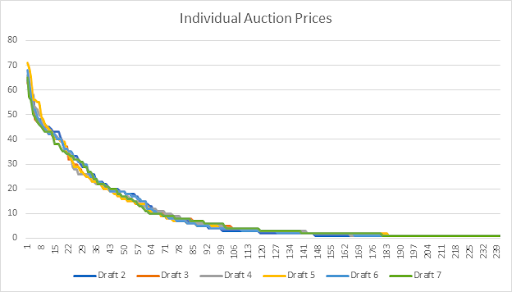
As you can see, the graphs don’t vary too much from league to league or even year to year. In these leagues 240 players will be rostered and there is a total budget of all 12 teams of $2400 (12 teams x $200 budget = $2400). We can see that prices quickly drop over the first 1/3 of the ADP range where the curve flattens out dramatically through the rest of the ADP range. This tells me there’s a high level of predictability in pricing AS LONG AS THE LEAGUE PARAMETERS DON’T CHANGE.
Now that last little conditional clause is vital. If I were to try to use this graph for a 10-team auction with a $200 budget, 16-man rosters, and Superflex, it probably would look somewhat different. But if I have even a year or two of historical pricing data from that league (or similar leagues), I could make a graph like this and feel quite confident that when this year’s auction is over it would fit very closely to the curve I created from this historical data.
The Next Step
My next step was to smooth that data out by averaging it all together like this graph below. We need to keep in mind that the prices are just arranged in descending order. Therefore, it’s not exactly by ADP but it’s very close. In a minute, we’ll put in some actual auction prices sorted by ADP and see how closely our curve predicts pricing. But this is the graph we get by averaging seven drafts worth of data together:
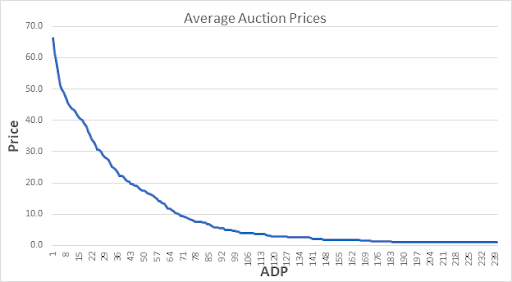
The relationship between price and ADP is quite simple, as we can see. Additionally, in similar leagues, it will not change much from auction to auction and year to year. Specific prices for any given player can and probably will vary somewhat from league to league though. For example, last year in three leagues all using this same format, Derrick Henry went for $39, $40, and $46).
Derrick Henry
But I also know that Derrick Henry was the 14th player by ADP in this format and if we look on the graph, the predicted cost of the 14th player was $41.80. So yeah, that’s pretty close. But am I just cherry-picking because this is the one player who happens to make my graph look accurate? Let’s find out. Let’s add the data from an 8th league using this format. This team was not included in building the Average Auction Price curve. However, this time instead of sorting by price from highest to lowest, we’ll sort by ADP to see how predictive our graph is.
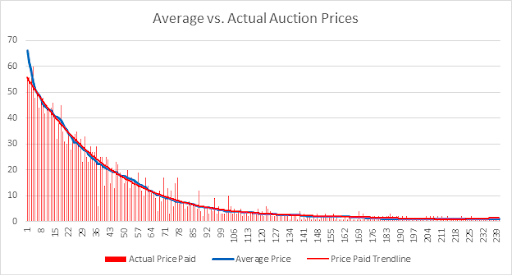
What’s going on here, you might ask? I set this graph up as a bar graph for the price paid for each of the 240 players purchased in this auction. Over that, I have superimposed our blue Average Auction Price line from the previous graph. And over THAT, I’ve superimposed the trendline for the Actual Price Paid data for each of those 240 players. Having trouble seeing the blue line?
Deciphering Historical Pricing Data
I don’t blame you, but that’s because it’s almost an exact fit with the trendline for this particular draft! There’s quite a bit of variability in the individual bars of player prices. Those which don’t reach the trendline are values vs. their normal ADO while those that reach above the trendline are players that a manager paid a premium to acquire. These variations can happen for a variety of reasons, as we will explore later, and are part of what makes auctions fun!
The Main Point
So all this is to say: If you can find historical pricing data for your auction, and you can find some relatively fresh ADP for your league, you can be confident that you have a handle on how much you should bid on any given player. To convert the above graphs into something you can actually use in an auction without a protractor and a magnifying glass is actually very simple. Just open up a spreadsheet like Excel or a Google Sheet and we can build a handy reference within a few minutes that looks like this:
| Ex Cost | Rnd | Rk | Name | Pos | Team | Auc1 |
| 66.2 | 1 | 1 | Christian McCaffrey(13) | RB | CAR | 55 |
| 61.7 | 1 | 2 | Jonathan Taylor (14) | RB | IND | 54 |
| 58.8 | 1 | 3 | Justin Jefferson (7) | WR | MIN | 57 |
| 54.0 | 1 | 4 | Cooper Kupp (7) | WR | LAR | 49 |
| 51.2 | 1 | 5 | Austin Ekeler (8) | RB | LAC | 45 |
| 49.7 | 1 | 6 | Ja’Marr Chase (10) | WR | CIN | 45 |
| 49.0 | 1 | 7 | Travis Kelce (8) | TE | KC | 44 |
| 47.2 | 1 | 8 | Dalvin Cook (7) | RB | MIN | 43 |
| 45.7 | 1 | 9 | Stefon Diggs (7) | WR | BUF | 44 |
| 44.7 | 1 | 10 | Saquon Barkley (9) | RB | NYG | 44 |
What Do the Columns Mean?
Column 1 is prices from a historical auction from this league in the first column (or an average of those prices if you have more than a year of data). These should be listed in exact order of highest to lowest.
Column 2 isn’t strictly necessary, but I just like to know what round I’m looking at if this were an actual snake draft.
Column 3 is just numbered from 1 to 240 because my leagues draft 240 players. If your leagues draft 160 players then you’d go to 160. This is helpful to have if you use sorts or filters on your list because sorting by this column quickly gets your sheet back to ADP order.
Column 4 is all the players sorted by ADP.
Columns 5-7
Column 5 is the positions of all the players, and I like to color code them just to make it easier to read at a glance. If your league uses colored stickers on a draft board (or online) matching these colors helps even more.
Column 6 is the player’s NFL team. Again, not strictly necessary, but nice.
Column 7 is left blank, until you are in the auction. As players are bought, you can fill in the price and you’re already collecting data you want for next year. Also, it helps you see how closely the auction is tracking with your expected player values
Q: But Dan, I don’t have any historical data for my auction! Now what do I do?
A: Well my friend, you are in a great deal of luck because PlayerProfiler has you all covered. You *did* buy their all-in package so you have access to the draft guide, right? If not, go buy it right now because you’re going to get your money’s worth really quick. Oh, you did already buy it? Awesome, you are sharp and you’re about to go dominate an auction! Here’s what you do.
Get the “World Famous” Draft Kit HERE ➔ www.playerprofiler.com/fantasy-football-draft-kit/
Go to the draft guide and click on the CHEATSHEETS tab. When that page opens, set your league parameters correctly (or as close as possible) and hit the DOWNLOAD button. This is going to give you a .csv file with auction values contained within. You can now use this info for your auction. DISCLAIMER: This is not nearly as good as having historical price data, but it’s far better than nothing. For reference, their auction values cover about 200 players in a 12-team auction with a $200 budget per team, which works out to about 16.5 players per team.
Valuation
That disclaimer brings up our final topic on valuation: Make sure you check any outside data for compatibility with your auction parameters and adjust if needed. You’ll definitely want to know how many players are in the dataset for auction prices and how many total dollars are allotted to these players, if the site you use doesn’t give this info. If the data doesn’t fit your parameters, you may need to make adjustments to it. You may also need to keep looking for a better fit.
PART II: Planning Your Strategy
By this point, you’ll need to have settled on a source for your ADP and a source for your expected player prices. Once you have these in front of you, it’s time to plot how you’re going to dominate your opponents in the auction room. In the remainder of this article, I’m going to presume a 12-team league with a $200 budget for each team. The first decision to make is whether to go with a Stars & Scrubs team build or go with Team Silo. Let’s look at each one and highlight the strengths and weaknesses:
Stars & Scrubs
This strategy revolves around rostering two super-elite players (Top 4-6 players in a snake draft) or three star players (generally Top 15-ish picks) and then filling in the blanks at the rest of your starting roster as best you can with whatever money you have left. You’ll be spending about $120 on two players and up to $150 on three players. It’s going to feel uncomfortable, but one of the big advantages of this strategy is we tend to be correct more often on players early in a typical snake draft (not including injuries) than players later in the draft.
This concentrates our spending in places where we have an abundance of confidence, and you definitely should not be spending up for any player you aren’t totally comfortable with rostering. This strategy will rely at least somewhat on your ability to find bargains throughout the rest of the auction. However, if your stars stay healthy, you’ll be tough to beat for two reasons.
One, players who have such early ADPs typically are more reliable at scoring big on a nearly weekly basis. Secondly, if you get more than your fair share of the players in this ADP range, by definition that means you’ll be playing against fewer of them during the course of the season. The downside, of course, is that if your stars disappoint for any reason whatsoever, it can be almost impossible to make the playoffs and/or advance if you do. It’s definitely a high-T strategy.
Team Silo
In this build, you will typically avoid rostering the most expensive players but instead will look to fill your starting lineup with as many players in the $10-30 range as possible. This strategy feels more resilient to injuries and underperformance. While this might be true, these players are typically coming from the 3rd through 7th rounds of snake drafts where we often hear of positional “dead zones” and players are just generally not as safe of bets than the stars in the Stars & Scrubs strategy.
Team Silo squads rarely finish at the bottom of the standings. However, they often lack the firepower at the top to win out in the playoffs UNLESS you nail almost every one of your starting player selections. But if you have a lot of confidence in your ability to pick the right players, this strategy is designed to fit you to a tee. You’ll be able to target specific players in this range in a way that just rarely ever works out in a snake draft and get more of those players to boot.
Of course, you can also blend these strategies to any extent you want. You can do this by rostering one super-elite player like Justin Jefferson and then going with a cheaper Team Silo after that. You could also plan to go super-cheap at one or two of your starting positions to compensate for the excess cost of your stud, while surrounding him with “Silo” talent at the rest of the positions.
Starters vs. Bench
Deciding how much to spend on your starters vs. how much to spend on your bench is actually pretty easy. You’ll want to heavily concentrate your budget on starters. In my leagues that we looked at to establish the Value Curve earlier, we start 10 players (1QB, 2RB, 2WR, 1TE, 2Flex, 1K, 1Def). Almost all the Kickers and Defenses typically go for $1 or $2, with usually one or two exceptions.
For this reason, I lump those positions in with the reserves when making my budget for starters, meaning I have 8 positions left. Multiply that by 12 teams and that means the league will be selecting 96 starters in total, sans K and Def. When I total up the top 96 players using Average Prices, $2118 of the $2400 total auction dollars (12 x $200) are spent on those starters. That’s 88.25% of the total.
Unless I want to give myself a handicap vs the rest of the league before the games even start, I need to be spending 85-90% of my $200 on those eight starters. That’s going to leave me only $20-30 dollars for all 10 of my bench players plus my Kicker and Defense. Sure, I could go with the strategy of spending a bit less on starters to give myself better bench options in case of injuries and during bye weeks, or any other sort of failure to produce by my starters.
Unintended Consequences
Unfortunately, the unintended consequence of having reserves that are borderline starters is that often they become TOO competitive with your starters when you’re filling out a weekly lineup. And that’s a bad thing because now your lineup decisions have gotten harder and more frustrating when you inevitably choose the wrong player. I’ve been in dozens of auctions over my years of playing fantasy football, and it’s very rare to see a team which spends a lot of money on quality bench players hoist the trophy at season’s end. They rarely have the top-end firepower needed to consistently beat the better teams in the league.
Now we’re finally getting to the fun part of prepping, which is putting together some different builds that we might use during the auction. A big part of dominating any auction is to be prepared for anything to happen. If you walk into the room with just one plan under your belt, there’s a good chance you’ll be tilting soon after the auction starts if the actual prices paid don’t fit the plan you budgeted for. The more agile and flexible your plans are, the more likely you can take advantage of bargains and pour excess funds saved into other positions.
Pivoting
For example, if you go into an auction and your only plan calls for you to go cheap at QB so you can spend up more at WR, you won’t have the courage or flexibility to jump on Patrick Mahomes when his bidding stalls out at $18 when you expected him to go for $25. Seems pretty clear this is a nice discount but if you throw out that $18 bid and win him, can you adjust your entire strategy on the fly while simultaneously keeping up with the ongoing nominations and bids in the auction? It’s harder than it seems UNLESS you’ve already prepared a plan which includes spending up for an elite QB, in which case it’s much easier to slot him in and take advantage of the discount.
Team Building Exercise
Start your team-building exercises by just going through your list of players and highlighting the ones you prefer. Then you can start putting together potential starting lineups. Keep in mind that it’s rare that everything will work our just as planned so you don’t want to get locked into specific players who may go for more money than you expected due to a variety of factors. It’s good to group similar players together and just plan to get whichever one out of that group still fits the budget when the Auctioneer announces “Sold!”
Maybe you don’t have a strong preference between Cam Akers, JK Dobbins, and James Conner, but you know you’d like an RB in their expected price range of $15-20. In that case you’d want to be in the bidding on all three. If Dobbins is nominated first and the bidding goes north of $20, you can confidently drop out, knowing you have two more whacks at the piñata in Akers and Conner. Having multiple options saves you money because it gives you the confidence to avoid chasing a particular player too high.
Sample Plan
This is also where you can cater to your own specific strengths or weaknesses as a drafter. If you always seem to be able to draft WRs who outperform their draft position, but you struggle with the TE position, then set your budget accordingly so you can spend up at TE and go a little cheaper at WR to take advantage of your edge. Indulge your dream scenarios too. Ever wondered what it would be like to roster both Justin Jefferson and Ja’Marr Chase? See what kind of team you can put around them and decide if it’s a workable build. Play around with different options and pick the best ones.
Here’s a sample plan for 2023:
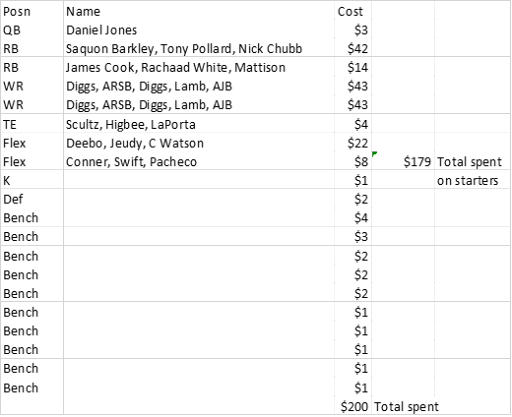
In this particular plan I decided to go with a Stars and Scrubs build and then added one more somewhat costly player for one of my flex positions. At WR I’m hoping to get two of the five I listed to fill both slots. To help fit it all in my budget, I had to go very cheap at QB and TE. I also like to budget a dollar or two higher than I hope to spend for the more expensive players just so I’m not too squeamish to go a little over my expected price if needed.
This is one plan I might actually bring into a 2023 auction, but it won’t be the only one. I’ll have about 7-8 more plans that I also like really well so when the action starts, I can settle in on a plan pretty quickly. Once you’ve got these strategies planned, you’re ready to swagger into your auction and dominate!
